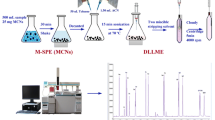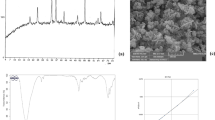Abstract
The method based on the dispersive solid-phase extraction (DSPE) by novel molybdenum disulfide modified with carbon dot (MoS2/CD) composite combined with high-performance liquid chromatography (HPLC) was developed for the determination of three brominated flame retardants (BFRs), including tetrabromobisphenol A (TBBPA), tetrabromobisphenol A bisallylether (TBBPA-BAE), and tetrabromobisphenol A bis(2,3-dibromopropyl ether) (TBBPA-BDBPE). Owing to the stacked planar structure and large surface area of MoS2, a large number of CDs can be easily loaded on the surface of MoS2. Benefiting from good dispersing capability of MoS2, similar density with analytes, and hydrogen bonds between CDs and the target analytes, the CDs on the surface of MoS2 as sorbent for the DSPE procedure exhibited good extraction performance. Under optimal conditions, application of the developed method to analyze BFRs from real water samples resulted in good recovery values ranging from 80 to 91% with relative standard deviation (RSD) values lower than 6.5%. Limits of detection (LODs) were in the range of 0.01–0.06 μg/L. The result above showed that the method has potential for the extraction and detection of trace-level BFRs from real water sample.

Owing to the stacked planar structure and large surface area of MoS2, a large number of CDs can be easily loaded on the surface of MoS2. Benefiting from good dispersing capability of MoS2, similar density with analytes, and hydrogen bonds between CDs and the target analytes, the prepared MoS2/CD composites as sorbent for the DSPE procedure exhibited good extraction performance. Accordingly, the extraction yield of BFRs was improved, which was favorable to its accurate determination in sample.






Similar content being viewed by others
References
Lee IS, Kang HH, Kim UJ, Oh JE. Brominated flame retardants in Korean river sediments, including changes in polybrominated diphenyl ether concentrations between 2006 and 2009. Chemosphere. 2015;126:18–24.
Schreder ED, La Guardia MJ. Flame retardant transfers from U.S. households (dust and laundry wastewater) to the aquatic environment. Environ Sci Technol. 2014;48:11575–83.
Jans U. Emerging brominated flame retardants in sediments and soils: a review. Curr Pollut Rep. 2016;2:213–23.
Turner A, Filella M. Bromine in plastic consumer products—evidence for the widespread recycling of electronic waste. Sci Total Environ. 2017;601–602:374–9.
European Brominated Flame Retardant Industry Panel (EBFRIP). EBFRIP questions Norwegian proposal to restrict the use of TBBPA and HBCD in consumer products, statement. EBFRIP. 2007.
Leonards P. Brominated flame retardants in office dust samples. In: Second international workshop on brominated flame retardants; 2001.
Covaci A, Harrad S, Abdallah MAE, Ali N, Law RJ, Herzke D, et al. Novel brominated flame retardants: a review of their analysis, environmental fate and behaviour. Environ Int. 2011;37:532–56.
Shi ZX, Wu YN, Li JG, Zhao YF, Feng JF. Dietary exposure assessment of Chinese adults and nursing infants to tetrabromobisphenol-A and hexabromocyclododecanes: occurrence measurements in foods and human milk. Environ Sci Technol. 2009;43:4314–9.
Birnbaum LS, Staskal DF, Diliberto JJ. Health effects of polybrominated dibenzo-p-dioxins (PBDDs) and dibenzofurans (PBDFs). Environ Int. 2003;29:855–60.
Fasfous II, Radwan ES, Dawoud JN. Kinetics, equilibrium and thermodynamics of the sorption of tetrabromobisphenol A on multiwalled carbon nanotubes. Appl Surf Sci. 2010;256:7246–52.
Xu R, Tang R, Liu S, Li F, Zhang B. An environmentally-friendly enzyme-based nanofibrous membrane for 3,3′,5,5′-tetrabromobisphenol removal. RSC Adv. 2015;5:64091–7.
Miyake Y, Tokumura M, Nakayama H, Wang Q, Amagai T, Ogo S, et al. Simultaneous determination of brominated and phosphate flame retardants in flame-retarded polyester curtains by a novel extraction method. Sci Total Environ. 2017;601-602:1333–9.
Wang X, Hu X, Zhang H, Chang F, Luo Y. Photolysis kinetics, mechanisms and pathways of tetrabromobisphenol A in water under simulated solar light irradiation. Environ Sci Technol. 2015;49:6683–90.
Daso AP, Fatoki OS, Odendaal JP, Olujimi OO. Polybrominated diphenyl ethers (PBDEs) and 2,2′, 4,4′, 5,5′-hexabromobiphenyl (BB-153) in landfill leachate in Cape Town, South Africa. Environ Monit Assess. 2013;185:431–9.
Chokwe TB, Okonkwo JO, Sibali LL, Ncube EJ. Optimization and simultaneous determination of alkyl phenol ethoxylates and brominated flame retardants in water after SPE and heptafluorobutyric anhydride derivatization followed by GC/MS. Chromatographia. 2012;75:1165–76.
Olukunle OI, Okonkwo OJ. Concentration of novel brominated flame retardants and HBCD in leachates and sediments from selected municipal solid waste landfill sites in Gauteng Province, South Africa. Waste Manag. 2015;43:300–6.
Abafe OA, Martincigh BS. An assessment of polybrominated diphenyl ethers and polychlorinated biphenyls in the indoor dust of e-waste recycling facilities in South Africa: implications for occupational exposure. Environ Sci Pollut Res. 2015;22:14078–86.
Daso AP, Fatoki OS, Odendaal JP. Development of analytical procedures for the simultaneous determination of tri- to heptabrominated diphenyl ethers and hexabrominated biphenyl (BB 153) in sediment samples. Water SA. 2011;37:331–8.
Yang J, Qiao JQ, Cui SH, et al. Magnetic solid-phase extraction of brominated flame retardants from environmental waters with graphene-doped Fe3O4 nanocomposites. J Sep Sci. 2015;38:1969–76.
Zhang ZH, Chen X, Rao W, Chen HJ, Cai R. Synthesis and properties of magnetic molecularly imprinted polymers based on multiwalled carbon nanotubes for magnetic extraction of bisphenol A from water. J Chromatogr B. 2014;965:190–6.
Yang J, Li JY, Qiao JQ, Cui SH, Lian HZ, Chen HY. Magnetic solid phase extraction of brominated flame retardants and pentachlorophenol from environmental waters with carbon doped Fe3O4 nanoparticles. Appl Surf Sci. 2014;321:126–35.
Huang G, Dong S, Zhang M, Zhang H, Huang T. Fabric phase sorptive extraction: two practical sample pretreatment techniques for brominated flame retardants in water. Water Res. 2016;101:547–54.
Anastassiades M, Lehotay SJ, Stajnbaher D, Schenck FJ. Fast and easy multiresidue method employing acetonitrile extraction/partitioning and “dispersive solid-phase extraction” for the determination of pesticide residues in produce. J AOAC Int. 2003;86:412–31.
Mijangos L, Bizkarguenaga E, Prieto A, Fernández LA, Zuloaga O. Simultaneous determination of a variety of endocrine disrupting compounds in carrot, lettuce and amended soil by means of focused ultrasonic solid-liquid extraction and dispersive solid-phase extraction as simplified clean-up strategy. J Chromatogr A. 2015;1389:8–18.
Pashaei Y, Ghorbani-Bidkorbeh F, Shekarchi M. Superparamagnetic graphene oxide-based dispersive-solid phase extraction for preconcentration and determination of tamsulosin hydrochloride in human plasma by high performance liquid chromatography-ultraviolet detection. J Chromatogr A. 2017;1499:21–9.
Sun Y, Zhou B, Lin Y, et al. Quantum-sized carbon dots for bright and colorful photoluminescence [J]. J Am Chem Soc. 2006;128:7756–7.
Salinas-Castillo A, Ariza-Avidad M, Pritz C, et al. Carbon dots for copper detection with down and upconversion fluorescent propenies as excitation sources [J]. Chem Commun. 2013;49:1103–5.
Chandra S, DaS P, Bag S, Laha D, Pramanik P. Symhesis, functionalization and bioimaging applications of highly fluorescent carbon nanoparticles [J]. Nanoscale. 2011;3:1533–40.
Yang S, Cao L, Luo P, et al. Carbon dots for optical imaging in vivo [J]. J Am Chem Soc. 2009;131:11308–9.
Wang C, Wu X, Li X, et al. Upconversion fluorescent carbon nanodots enriched with nitrogen for light harvesting [J]. J Mater Chem. 2012;22:15522–5.
Yu C, Li X, Zeng F, Zheng F, Wu S. Carbon-dot-based ratiometric fluorescent sensor for detecting hydrogen sulfide in aqueous media and inside live cells [J]. Chem Commun. 2013;49:403–5.
Du G, Guo Z, Wang S, Zeng R, Chen Z, Liu H. Superior stability and high capacity of restacked molybdenum disulfide as anode material for lithium ion batteries [J]. Chem Commun. 2010;46:1106–8.
Feng C, Ma J, Li H, Zeng R, Guo Z, Liu H. Synthesis of molybdenum disulfide (MoS2) for lithium ion battery applications. Mater Res Bull. 2009;44:1811–5.
Rapoport L, Fleischer N, Tenne R. Applications of WS2 (MoS2) inorganic nanotubes and fullerene-like nanoparticles for solid lubrication and for structural nanocomposites. J Mater Chem. 2005;15:1782–8.
Xiang Q, Yu J, Jaroniec M. Synergetic effect of MoS2 and graphene as cocatalysts for enhanced photocatalytic H2 production activity of TiO2 nanoparticles. J Am Chem Soc. 2012;134:6575–8.
Tenne R. Advances in the synthesis of inorganic nanotubes and fullerene-like nanoparticles. Angew Chem. 2003;42:5124–32.
Skrabalak SE, Suslick KS. Porous MoS2 synthesized by ultrasonic spray pyrolysis. J Am Chem Soc. 2005;127:9990–1.
Bourlinos AB, Stassinopoulos A, Anglos D, Zboril R, Karakassides M, Giannelis EP. Surface functionalized carbogenic quantum dots [J]. Small. 2008;4:455–8.
Peng H, Travassejdic J. Simple aqueous solution route to luminescent carbogenic dots from carbohydrates [J]. Chem Mater. 2009;21:5563–5.
Liu S, Zhang X, Shao H, Xu J, Chen F, Feng Y. Preparation of MoS2 nanofibers by electrospinning. Mater Lett. 2012;73:223–5.
Zhou J, Booker C, Li R, Zhou X, Sham T, Sun X, et al. An electrochemical avenue to blue luminescent nanocrystals from multiwalled carbon nanotubes (MWCNTs). J Am Chem Soc. 2007;129:744–5.
Alpendurada MF. Solid-phase microextraction: a promising technique for sample preparation in environmental analysis. J Chromatogr A. 2000;889:3–14.
Wang M, Yuan H, Deng W, Bi W, Yang XA. Taiji-principle-designed magnetic porous C-doped graphitic carbon nitride for environment-friendly solid phase extraction of pollutants from water samples. J Chromatogr A. 2015;1412:12–21.
Liu L, Liu A, Zhang Q, Shi J, He B, Yun Z, et al. Determination of tetrabromobisphenol-A/S and their main derivatives in water samples by high performance liquid chromatography coupled with inductively coupled plasma tandem mass spectrometry. J Chromatogr A. 2017;1497:81–6.
Liu A, Shen Z, Tian Y, Shi R, Liu Y, Zhao Z, et al. Thin-layer chromatography coupled with high performance liquid chromatography for determining tetrabromobisphenol A/S and their derivatives in soils. J Chromatogr A. 2017;1526:151–6.
Funding
The authors appreciate the support from the Natural Science Foundation of Shaanxi Province (2017JM2038).
Author information
Authors and Affiliations
Corresponding author
Ethics declarations
Conflict of interest
The authors declare that they have no competing interests.
Rights and permissions
About this article
Cite this article
Dong, S., Lou, Q., Huang, G. et al. Dispersive solid-phase extraction based on MoS2/carbon dot composite combined with HPLC to determine brominated flame retardants in water. Anal Bioanal Chem 410, 7337–7346 (2018). https://doi.org/10.1007/s00216-018-1342-x
Received:
Revised:
Accepted:
Published:
Issue Date:
DOI: https://doi.org/10.1007/s00216-018-1342-x




